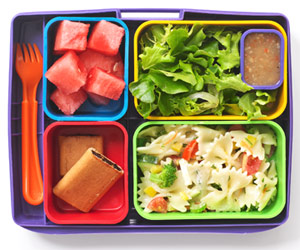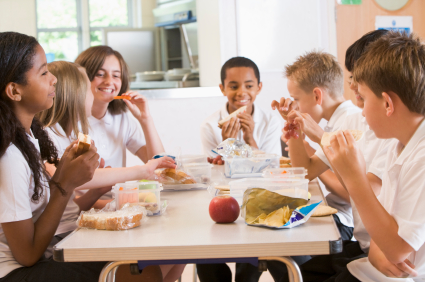Though the weather in most places appears otherwise, summer is ending, and it’s time to go back to school! While  kids everywhere are sharpening pencils, organizing schedules and catching up on summer reading lists, public schools nationwide are preparing their cafeterias for the United States Department of Agriculture’s new school lunch guidelines. The government’s regulations will take effect this fall, and enforce limitations on both the calorie and sodium levels of school meals. The guidelines also require students to take a minimum of one fruit or vegetable per meal, and school cafeterias to offer legumes and red, orange or dark green vegetables once per week at the very least. There is even a ban on trans fats within the guidelines.
kids everywhere are sharpening pencils, organizing schedules and catching up on summer reading lists, public schools nationwide are preparing their cafeterias for the United States Department of Agriculture’s new school lunch guidelines. The government’s regulations will take effect this fall, and enforce limitations on both the calorie and sodium levels of school meals. The guidelines also require students to take a minimum of one fruit or vegetable per meal, and school cafeterias to offer legumes and red, orange or dark green vegetables once per week at the very least. There is even a ban on trans fats within the guidelines.
“Obesity, diabetes, heart disease, high blood pressure are all diet-related health issues that cost this country more than $120 billion each year…. While the dollar figure is shocking in and of itself, the effect on our children is even more profound. Nearly a third of the children in this country are either overweight or obese….that number is just unacceptable.” – First Lady Michelle Obama on the state of children’s nutrition in America
The new USDA guidelines can only mean GREAT things for the nation’s school food system and its ever-growing childhood obesity rate. However, commanding kids to take an apple or some carrots at lunchtime will only have a beneficial effect if the kids actually eat the nutritional foods made available to them. Kristen Wyatt’s recent article “Healthy school lunches: How to get kids to eat them?” provides some very helpful tips and research on how to fully implement the government’s guidelines for the kids’ AND the country’s best advantage.
Around 12 noon, or shortly thereafter, the hallways of most schools echo with the riotous sounds of kids stampeding to the cafeteria. Lunch is usually the one period of the academic day during which students are free from the confines of the classroom – a time to chat, convene with friends, etc. This kind of break is necessary to maintain the work ethic and preserve the sanity of anyone, regardless of their age. Lunchtime is essential, and should be treated that way. Studies show that presenting lunchtime as an invaluable interval of the academic day, during which kids should refuel their bodies and refresh their minds, helps promote healthier food intake among students.

Transforming kids’ understanding of what a lunch period means in relation to the rest of their day entails increasing their awareness of how food can either help or hurt both their bodies and their productivity level. Thus some schools have established “food coaches” to provide information on nutrition, samples and advice in cafeterias. Wyatt’s piece also offers an alternative to coaches who come in from outside (adults and often parents), who may be more relatable and approachable for preteens and teens. She suggests that middle and high schools appoint “food ambassadors,” or students prepared to mentor their peers on nutrition and healthy lunch choices.
In efforts to discover what draws kids to certain foods, and to better understand the decisions behind the contents of their lunch trays, some schools have gone so far as to film the food intake of their students and “test-market” new, nutritional cafeteria products by organizing menu surveys which distinguish how kids feel about the healthier food’s taste and sometimes even its presentation.
Colorado State University professor Leslie Cunningham-Sabo, provided enriching insight into the lunching habits of students when she conducted a study that involved “before” and “after” photographs of students’ lunch trays. Her work concluded that more fruits and vegetables were chosen and eaten by students who had lunchtime after recess, as opposed to before it. Schools should take experiments such as this one into consideration when making scheduling decisions.
A recess snack cart is another idea put forth in Wyatt’s article. Whether they are presented in a cart, on a table, or elsewhere, offering nutritious snacks to students during recess has proven to be an extremely effective way to promote healthy choices and enhance productivity (maybe even to avoid the drop in attention span which tends to affect most kids prior to lunch).
A final and relatively simple tactic with which schools could increase their students’ intake of fruits and vegetables is to display them in an accessible way right next to the cash register as supermarkets do with impulse buys like chewing gum.
It’s a new school year, a fresh start, so start it off right! Eat your fruits and vegetables and use food the way you should, to feed your brain and your body and to make your school day, your child’s school day or your students’ as productive as possible!

